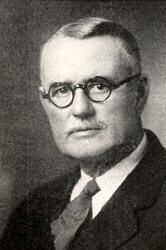Hymn History: In the Garden & Author: Charles Austin Miles
“The song [‘In the Garden’] has always been one of my favorites. … Charles Austin Miles … was a very talented man. Along with being a successful songwriter he was a church music director, a pharmacist, and a photographer who developed his own photos.”
(Blind Pig & The Acorn)
The Origin of the Hymn “In the Garden”
Few hymns in Christian music have captured the quiet intimacy of fellowship with Christ as tenderly as “In the Garden.” With its opening line, “I come to the garden alone, while the dew is still on the roses,” it draws the listener into a peaceful, personal encounter with the risen Savior. This beloved hymn, written in 1912 by Charles Austin Miles, has comforted generations of believers and remains a favorite in worship services, funerals, and moments of private devotion.
The Hymn’s Author: Charles Austin Miles
Charles Austin Miles was born on January 7, 1868, in Lakehurst, New Jersey. Though trained as a pharmacist, Miles had a deep love for music and a strong Christian faith. After several years in pharmacy, he left that profession to pursue full-time work in gospel music—a decision that reflected both his conviction and his calling. He soon found employment with the Hall-Mack Company of Philadelphia, one of the most prominent gospel song publishers of the era.
Miles became not only a composer but also a music editor, working with many other hymn writers of his time. His skill for writing words and music that were both simple and heartfelt made him one of the leading figures in early 20th-century American gospel music. Over his lifetime, he wrote or edited hundreds of songs, but none would surpass the popularity of “In the Garden.”
The Moment of Inspiration
The origin of “In the Garden” traces back to a deeply spiritual experience Miles had while reading the Gospel of John. In his own words, Miles described how he came upon the passage in John 20 where Mary Magdalene visits the tomb of Jesus and discovers it empty. As she weeps, the risen Lord appears to her and gently calls her by name.
Miles later recalled that moment vividly:
“One day in March 1912, I was seated in the darkroom where I kept my photographic equipment and organ. I drew my Bible toward me; it opened at my favorite chapter, John 20. I read it as I had read it many times before, with the same sense of joy this new and wondrous story gives. That meeting of Jesus and Mary had lost none of its power. It was as though I were in that garden. I saw Mary there, heard her voice, and knew she was talking to Jesus. I felt I was part of the scene.”
As Miles meditated on the passage, the words and melody began to form in his mind. He described it as a divine moment—something that seemed to pour out of his heart without effort. He quickly wrote down the lyrics and composed the tune at his organ, naming the song “In the Garden.”
Themes and Meaning
Unlike many hymns of its time, “In the Garden” does not focus on doctrine, church life, or evangelism. Rather, it expresses the deep personal relationship between the believer and Christ. The hymn captures the peace and joy that comes from spending quiet time with the Savior, as reflected in the refrain:
And He walks with me, and He talks with me,
And He tells me I am His own;
And the joy we share as we tarry there,
None other has ever known.
This message of intimate fellowship with God resonated powerfully with Christians who longed for comfort and closeness in their faith. It speaks to the reality that Christianity is not merely a belief system but a living relationship with Jesus Christ—a theme that has made the hymn timeless.
Publication and Reception
After writing the hymn, Miles submitted it to the Hall-Mack Company, where it was first published in 1912. It quickly gained popularity through revival meetings, Sunday schools, and evangelistic campaigns. Evangelist Billy Sunday and his music leader Homer Rodeheaver were instrumental in spreading the song across America. Rodeheaver, who often sang “In the Garden” as a solo at Sunday’s crusades, helped make it one of the most beloved hymns of the early 20th century.
The hymn’s peaceful tone and hopeful message also made it a favorite at funerals and memorial services, where its words offered comfort to the grieving. Over time, it was recorded by numerous artists, both sacred and secular, including Tennessee Ernie Ford, Elvis Presley, and Doris Day. Each rendition captured the quiet reverence that defines the song’s spirit.
A Lasting Legacy
Charles Austin Miles lived until 1946, continuing to write and edit hymns throughout his life. Though he composed many gospel songs, “In the Garden” remained his crowning achievement. In reflecting on the hymn, Miles once wrote, “It is not an experience limited to one hour of the day. It is a daily companionship with the Lord.”
That, perhaps, is the secret to the song’s enduring power. “In the Garden” does not rely on complex theology or dramatic imagery; instead, it invites believers into a moment of stillness—a spiritual garden where Christ’s presence brings peace, assurance, and joy.
Over a century later, the hymn continues to remind Christians of the beauty of walking with Jesus day by day. Whether sung softly at sunrise or in the quiet of a church service, its simple truth endures: in the garden of the soul, the Savior still walks and talks with those who love Him.
“In the Garden” remains one of the most cherished hymns in Christian worship—a song born not from grand inspiration, but from a quiet moment of faith and love, shared between one man and his Lord.
Related
Sorry, no records were found. Please adjust your search criteria and try again.
Sorry, unable to load the Maps API.
